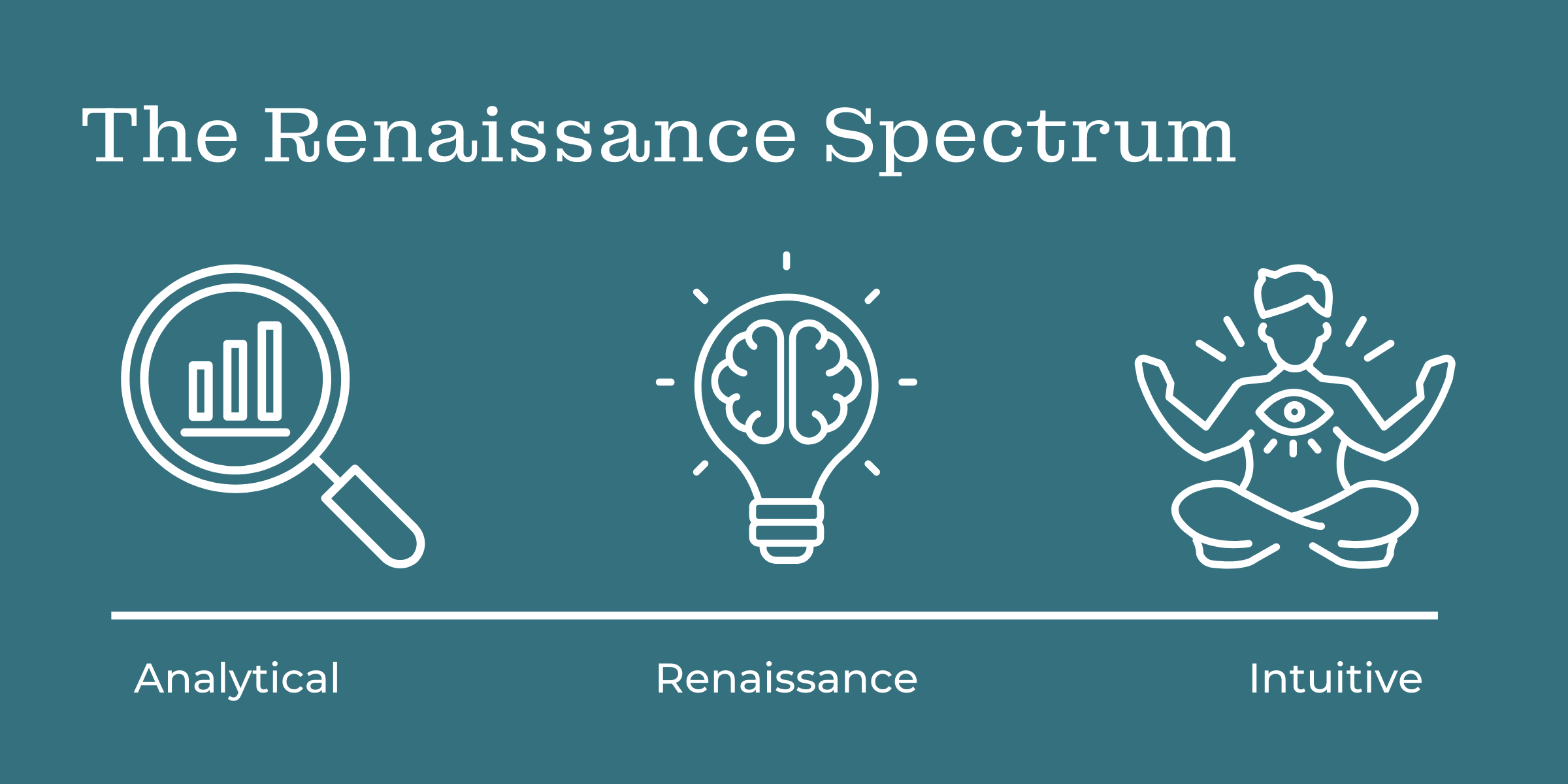The Renaissance Spectrum
All of us are wired differently. And that’s great! It makes life interesting. Biologically, we need diversity to survive. Our different skills help us thrive and grow as a society.
That said, it can be helpful to understand how you’re wired in order to become more aware of how you prefer to operate. When you have this awareness, it becomes easier to interact and work with others.
Our framework orients around the notion of someone being more analytical or intuitive leaning. If you’re somewhere in the middle, then you’re more renaissance.
When we’re describing how renaissance you are, we’re referring to the popular term of a “renaissance man” which is a “a person with many talents or areas of knowledge” as defined by the Oxford Language dictionary. Of course, I prefer the term renaissance person, which is more inclusive, but the most commonly heard version is renaissance man and why I’m mentioning it.
Of course, all of this is a spectrum and it can change throughout your life as you learn and grow. You can consciously choose to change your position on the spectrum if you focus on developing your skills in a certain direction, which we’ll talk more about in this article.
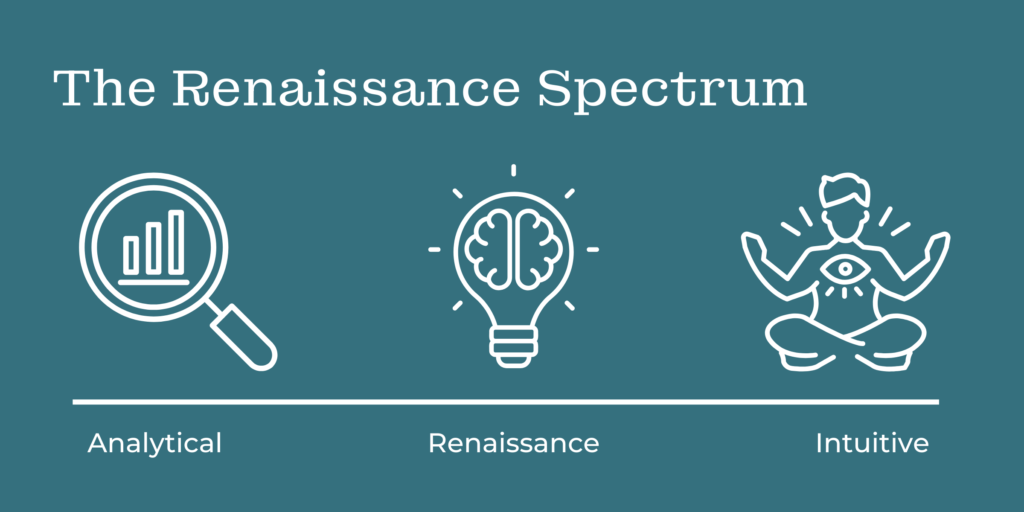
While the renaissance spectrum provides a useful framework, it’s important to note that the two polarities of analytical and intuitive work together. Many tasks require a blend of analytical and intuitive thinking, and individuals may exhibit a mix of both skill sets.
However, many of us are predominantly wired towards one extreme and we may fall in different places on that spectrum.
The Different Types on the Renaissance Spectrum
Understanding our natural cognitive tendencies can help us better navigate our personal and professional lives while appreciating the diverse ways people process information and solve problems. The three cognitive types: analytical, intuitive, and renaissance each offer unique strengths and approaches to engaging with the world around us.
The Analytical Type
If you’re an analytical type, that typically means that you excel in logical reasoning, analytical thinking, and detail-oriented tasks. You often prefer structured environments and may be more comfortable with numbers, language, and systematic processes. You might approach problems in a sequential manner and enjoy tasks that involve critical thinking and organization.

Key traits of the analytical type include:
- Analytical Thinking: Logical reasoning, critical thinking, and problem-solving.
- Mathematical Abilities: Proficiency in calculations and quantitative analysis.
- Language Skills: Strong verbal skills, reading, writing, and grammar.
- Detail-Oriented: Focus on facts, details, and organization.
- Sequential Processing: Preference for step-by-step processes and structured approaches.
As an analytical type, your strengths lie in logical reasoning, mathematical aptitude, and systematic problem-solving, combined with strong language skills and attention to detail that make you particularly effective in structured environments and methodical processes.
While your analytical strengths are valuable, you may sometimes struggle with situations that require quick, intuitive decisions or emotional responses. Your preference for structure and detailed analysis might lead to analysis paralysis, where the desire for perfect information delays decision-making. You might also find it challenging to work in ambiguous situations or environments where rules and processes aren’t clearly defined, and your focus on logic might sometimes make it difficult to connect with others who operate more on emotion or intuition.
The Intuitive Type
If you’re an intuitive type, that typically means that you tend to excel in creative thinking, holistic processing, and emotional intelligence. You often have a strong sense of intuition and are comfortable with ambiguity and abstract concepts. You may prefer visual and spatial learning, thriving in environments that encourage innovation and artistic expression.
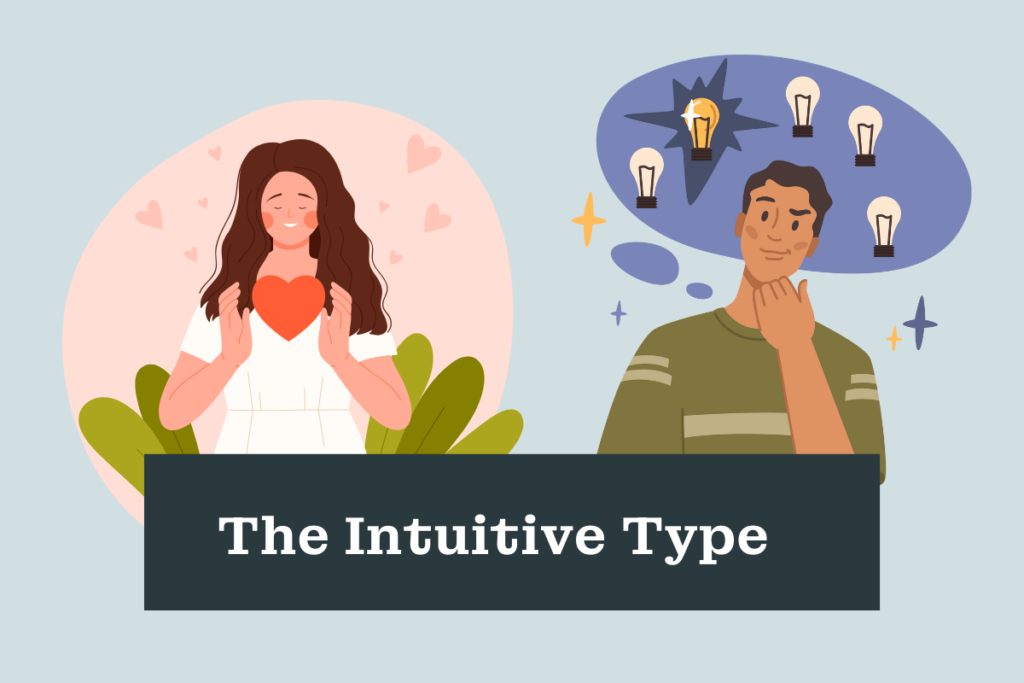
Key traits of the intuitive type include:
- Creative Thinking: Imagination, innovation, and artistic abilities.
- Holistic Processing: Understanding concepts as a whole rather than in parts.
- Emotional Intelligence: Ability to perceive and express emotions and empathy.
- Spatial Awareness: Skills in visualizing and manipulating objects in space.
- Intuition: Relying on gut feelings and instinctive responses.
As an intuitive type, your strength lies in your ability to process information holistically and creatively, combining emotional intelligence with strong spatial awareness and instinctive decision-making to excel in environments that value innovation and abstract thinking.
Your intuitive nature, while powerful, can present challenges in environments that demand strict adherence to procedures or detailed documentation. You might struggle with breaking down complex problems into smaller, manageable steps, preferring to grasp concepts holistically instead. This can make it difficult to explain your thought process to others, particularly in professional settings that value explicit, step-by-step reasoning. Additionally, your reliance on gut feelings might lead to overlooking important details or having difficulty when required to provide concrete, data-driven justifications for your decisions.
The Renaissance Type
If you’re a renaissance type, that typically means you possess a diverse range of skills and interests spanning both analytical and creative domains. While you might not achieve absolute mastery in every area, your broad knowledge base allows you to understand and engage meaningfully across multiple disciplines.
You thrive on learning across different fields and can readily draw connections between seemingly unrelated domains, embodying the concept of a “jack of all trades” but with enough depth to be notably competent in each area. You often enjoy both intellectual and artistic pursuits, adapting easily between different modes of thinking and expression while maintaining a perpetual curiosity for new knowledge and experiences.

Key traits of the renaissance type include:
- Versatility: Ability to perform competently in multiple domains and switch between different thinking styles.
- Interdisciplinary Thinking: Skill in connecting concepts across different fields and disciplines.
- Balanced Processing: Comfortable with both analytical and intuitive approaches.
- Adaptive Learning: Quick to grasp new concepts and apply knowledge in various contexts.
- Broad Competence: Maintaining solid proficiency across multiple areas rather than mastery in one.
As a renaissance type, your strength lies not in specialized expertise but in your versatility and ability to bridge different domains of knowledge, combining broad understanding with practical competence to tackle complex challenges and pursue diverse interests with balanced proficiency.
While being versatile can be advantageous, it may lead to feelings of being unfocused or underqualified in more specialized contexts. Your broad range of interests and capabilities can sometimes work against you, particularly in specialized professional environments that value deep expertise over broad knowledge.
You might find yourself spread too thin, attempting to maintain competency across multiple areas while watching others advance further in their specialized fields. This can lead to feelings of being a “master of none,” especially in competitive situations where deep expertise is prized over versatility. You might also struggle with focus and prioritization, as your curiosity pulls you in multiple directions, making it challenging to dedicate the time needed to develop true mastery in any single area.
Adjusting your place on the renaissance spectrum
It’s important to recognize that there’s no “better” type – each brings unique strengths and perspectives that are valuable in different contexts. As I mentioned in the beginning, having different types allows us to thrive and grow as a society, bringing the essential diversity that we need.
While you can certainly work to develop traits from other types, it’s equally valid to embrace and deepen your natural inclinations. Your inherent way of thinking and processing information is part of what makes you unique and effective in your own way.
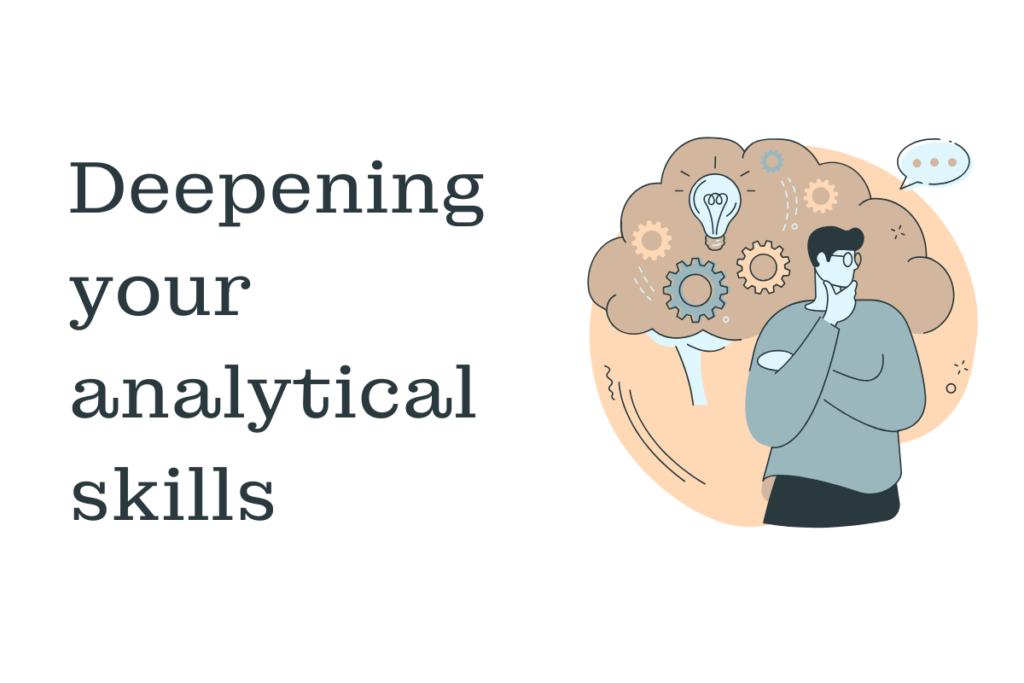
Deepening your analytical skills
Whether you’re an intuitive or renaissance type wanting to deepen your analytical skills or an analytical type wanting to enhance their existing skillset, here are some steps you might consider to grow your analytical abilities.
- Develop Analytical Skills
- Engage in activities that require logical reasoning, such as puzzles, strategy games, or math exercises.
- Take online courses in subjects like statistics, coding, or data analysis to enhance your analytical abilities.
- Practice Structured Problem-Solving
- Learn and apply structured problem-solving methods, such as the scientific method or design thinking.
- Use frameworks like SWOT analysis to evaluate situations more systematically.
- Explore Writing and Language
- Write essays or reports to develop clarity and structure in your communication.
- Join a book club to discuss and analyze different perspectives on literature.
- Learn to Embrace Constraints
- Set specific guidelines or constraints when working on creative projects to encourage structured creativity.
- Challenge yourself to create within a defined framework, like writing a story with limited vocabulary.
- Engage in Analytical Discussions
- Participate in discussions or debates that focus on critical analysis and logical reasoning.
- Collaborate with individuals who have a strong analytical background to gain new insights.
- Take Courses in Math and Science
- Enroll in classes that focus on quantitative skills, logic, or technology.
- Use online platforms to learn programming, which can enhance your logical and analytical thinking.
- Practice Mind Mapping
- Create mind maps for your ideas to visually organize and connect thoughts, blending creativity with structure.
- Use mind mapping software or tools to help structure complex information.
- Seek Feedback on Your Work
- Actively seek constructive criticism from peers or mentors to refine your projects and ideas.
- Learn to analyze feedback objectively to identify areas for improvement.
By utilizing these strategies, you can strengthen your analytical and structured thinking skills while maintaining your creative strengths.
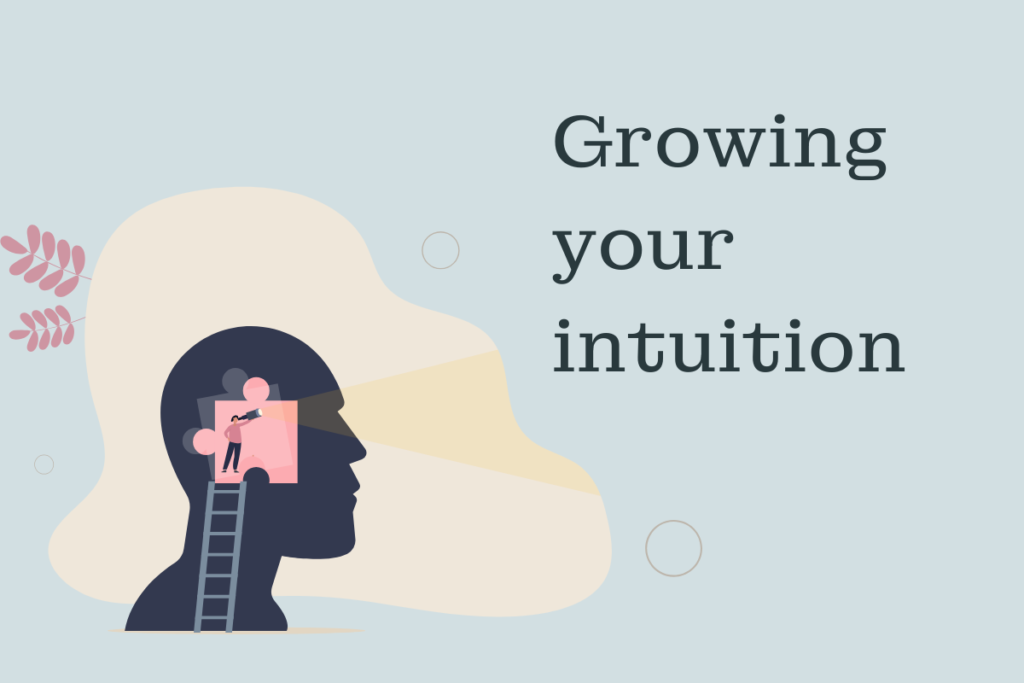
Deepening your intuitive skills
Whether you’re an analytical or renaissance type wanting to deepen your intuitive skills or an intuitive type wanting to enhance their existing skillset, here are some steps you might consider to grow your intuitive abilities.
- Engage in Creative Activities
- Try painting, drawing, or playing a musical instrument to stimulate creative thinking.
- Join a class or workshop that encourages artistic expression.
- Practice Brainstorming
- Set aside time for free form brainstorming sessions where you explore ideas without immediate judgment.
- Use mind maps to visually organize thoughts and explore connections between concepts.
- Participate in Group Discussions
- Engage in discussions or debates that challenge your perspectives and encourage open-mindedness.
- Collaborate with others on projects to gain different viewpoints.
- Explore New Hobbies
- Take up activities like writing fiction, photography, or dance, which require a more intuitive and less structured approach.
- Try improvisational classes (e.g., improv comedy) to develop spontaneity.
- Practice Mindfulness and Meditation
- Mindfulness exercises can help you tap into your intuition and become more aware of your emotions and thoughts.
- Meditation can foster a more holistic perspective by quieting the analytical mind.
- Learn about Non-linear Thinking
- Explore books or resources on systems thinking, which emphasizes interconnections and relationships over linear cause-and-effect.
- Familiarize yourself with design thinking methodologies, which prioritize empathy and creativity in problem-solving.
- Embrace Ambiguity
- Deliberately put yourself in situations where the outcomes are uncertain or where there is no clear right answer.
- Practice accepting and navigating ambiguity in decision-making.
- Set Creative Goals
- Establish personal goals that require creative output, such as writing a short story or completing an art project.
- Allow yourself the freedom to experiment without the pressure of perfection.
By actively working on these areas, you can develop a more balanced skill set, incorporating creativity and intuition alongside your analytical strengths.

Deepening your renaissance skills
Whether you’re an analytical or intuitive type wanting to develop renaissance qualities, or a renaissance type wanting to enhance your existing versatility, here are some steps you might consider to grow your renaissance abilities.
- Cultivate Cross-Disciplinary Learning
- Take courses in subjects vastly different from your current expertise.
- Look for connections between seemingly unrelated fields (like art and mathematics, or music and physics).
- Practice Cognitive Flexibility
- Switch between different thinking modes (analytical and intuitive) deliberately during problem-solving.
- Challenge yourself to approach familiar problems using unfamiliar methods.
- Develop Multiple Skills Simultaneously
- Balance technical and creative pursuits in your daily routine.
- Maintain multiple ongoing projects that require different skill sets.
- Build Bridges Between Disciplines
- Start projects that combine multiple fields (like digital art that uses programming).
- Join interdisciplinary groups or communities that value diverse perspectives.
- Maintain Breadth Without Sacrificing Depth
- Set learning goals that involve both broad exploration and focused study.
- Practice time management to maintain competency across multiple areas.
- Engage in Varied Communication Styles
- Practice explaining complex concepts both analytically and metaphorically.
- Learn to adapt your communication style to different audiences.
- Pursue Complementary Skills
- Identify skills that naturally complement each other (like public speaking and data visualization).
- Look for ways to combine different abilities in unique and valuable ways.
- Create Integration Opportunities:
- Look for projects that allow you to use multiple skill sets simultaneously.
- Seek roles or opportunities that value versatility and cross-functional abilities.
By actively working on these areas, you can develop a more integrated skill set that combines analytical rigor with creative insight, while maintaining the breadth that characterizes a true renaissance approach.
Remember that the goal isn’t to become an expert in everything, but rather to develop sufficient competency across multiple domains to create unique value through their combination.

Final thoughts
Throughout this article, we’ve explored three distinct cognitive types along the renaissance spectrum – the analytical, the intuitive, and the renaissance – each bringing unique strengths and perspectives to how we process information and engage with the world.
We’ve examined their characteristic traits, common challenges, and potential paths for growth. But perhaps the most important takeaway is this: there is no “right” type to be, nor is there any obligation to change your natural tendencies.
You might recognize yourself strongly in one of these types and feel inspired to lean further into those strengths – whether that’s developing your analytical precision, nurturing your intuitive insights, or expanding your renaissance versatility.
Or you might feel drawn to explore and develop traits from a different type, gradually shifting your position on this spectrum of cognitive styles.
Equally valid is the choice to simply acknowledge and appreciate your natural tendencies, using this awareness to better understand yourself and how you interact with the world around you.
The purpose of understanding these types isn’t to box ourselves into categories or force change, but rather to provide a framework for self-reflection and, if desired, intentional growth. Whether you choose to enhance your existing strengths, explore new territories, or simply maintain greater awareness of your natural inclinations, the choice is entirely yours to make.
If nothing else, I hope this exploration of cognitive types has been both entertaining and illuminating, offering you a fresh perspective on the different ways we can approach thinking, learning, and problem-solving. After all, it’s our diversity in thinking styles that enables us to tackle challenges from multiple angles and contribute uniquely to our shared human experience.

